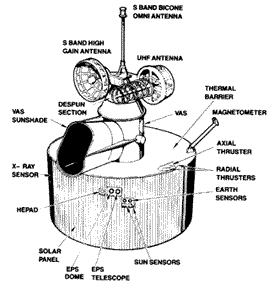
(29b) Satellites which look down and observe the EarthThese include satellites which monitor the weather, such as the GOES series (one of which is shown on the right) of the US National Oceanic and Atmospheric Administration (NOAA). They are in synchronous orbit, keeping the same area in view as the Earth rotates. To this class also belong "spy satellites" which observe the ground from low circular orbits. For obvious reasons they are rarely described in public, but some are said to have sizes comparable to that of the Hubble telescope. The US Air Force furthermore sponsors polar satellites of the DMSP series, scanning the globe for rocket launches. Other satellites scan the Earth for a variety of purposes: for instance, the French SPOT series of surveillance satellites mainly serves commercial customers (one SPOT observed among other things the Soviet nuclear reactor accident in Chernobyl). NASA's Polar collects images of the polar aurora (as did the Swedish "Viking" and "Freja", and several earlier satellites), and the US Landsat series was primarily meant to observe vegetation. The Canadian satellite Alouette in 1962 bounced radio signals off the top of the ionosphere, and UARS (Upper Atmosphere Research Satellite) is currently studying the Earth atmosphere. A large collection of Earth-observing missions, the EOS missions, is being prepared by NASA. |


